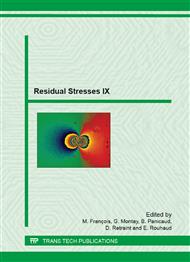[1]
M. Gotoh, K. Seki, M. Shozu, H. Hirose, and T. Sasaki, Influence of steel grain size on residual stress in grinding processing, Mater. Sci. Forum 638-642 (2010) 2389-94.
DOI: 10.4028/www.scientific.net/msf.638-642.2389
Google Scholar
[2]
H. -H. Fu, D.J. Benson, and M. A. Meyers, Analytical and Computational Description of effect of grain size on yield stress of metals, Acta Mater. 49 (2001) 2567–82.
DOI: 10.1016/s1359-6454(01)00062-3
Google Scholar
[3]
C. Wei, S. Lin, R.G. Qian, and J.M. Hsiao, Computer simulation of effect of grain size on the properties of polycrystalline specimens by finite element method, Acta Mater. 39 (1991) 2051-57.
DOI: 10.1016/0956-7151(91)90174-y
Google Scholar
[4]
S. Berbenni, V. Favier, and M. Berveiller, Impact of the grain size distribution on the yield stress of heterogeneous materials, Int. J. Plast. 23 (2007) 114–142.
DOI: 10.1016/j.ijplas.2006.03.004
Google Scholar
[5]
K. Tokaji, T. Ogawa, and K. Ohya, The effect of grain size on small fatigue crack growth in pure titanium, Int. J. Fatigue 16 (1994) 571-78.
DOI: 10.1016/0142-1123(94)90483-9
Google Scholar
[6]
D.J. Dunstan and A.J. Bushby, Grain size dependence of the strength of metals: The Hall–Petch effect does not scale as the inverse square root of grain size, Int. J. Plast. 53 (2014) 56-65.
DOI: 10.1016/j.ijplas.2013.07.004
Google Scholar
[7]
R. M'Saoubi and H. Chandrasekaran, Role of phase and grain size on chip formation and material work hardening during machining of single and dual phase steels, Ironmaking Steelmaking 31 (2004) 258-264.
DOI: 10.1179/030192304225012141
Google Scholar
[8]
Y.D. Wang, R. Lin Peng, X.L. Wang, and R.L. McGreevy, Grain-orientation-dependent residual stress and the effect of annealing in cold-rolled stainless steel, Acta Mater. 50 (2002) 1717-34.
DOI: 10.1016/s1359-6454(02)00021-6
Google Scholar
[9]
A. Simoneau, E. Ng, and M.A. Elbestawi, Grain size and orientation effects when microcutting AISI 1045 steel, Ann. CIRP 56 (2007) 57-60.
DOI: 10.1016/j.cirp.2007.05.016
Google Scholar
[10]
M.N.A. Nasr, E-G. Ng, and M.A. Elbestawi, Modelling the effects of tool-edge radius on residual stresses when orthogonal cutting AISI 316L, Int. J. Mach. Tool Manu. 47 (2007) 401–411.
DOI: 10.1016/j.ijmachtools.2006.03.004
Google Scholar
[11]
M.N.A. Nasr, E-G. Ng, and M.A. Elbestawi, A modified time-efficient FE approach for predicting machining-induced residual stresses, Finite Elem. Anal. Des. 44 (2008) 149-161.
DOI: 10.1016/j.finel.2007.11.005
Google Scholar
[12]
M.N.A. Nasr, E-G. Ng, and M.A. Elbestawi, Effects of workpiece thermal properties on machining-induced residual stresses – thermal softening and conductivity, Proc. Inst. Mech. Eng., B J. Eng. Manuf. 221 (2007) 1387-1400.
DOI: 10.1243/09544054jem856
Google Scholar
[13]
R. M'Saoubi, J.C. Outeiro, B. Changeux, J.L. Lebrun, and A.M. Dias, Residual Stress Analysis in Orthogonal Machining of Standard and Resulfurized AISI 316L Steels, J. of Mats Proc Tech, 96 (1999) 225-233.
DOI: 10.1016/s0924-0136(99)00359-3
Google Scholar
[14]
A.B. Sadat, Effect of High Cutting Speed on Surface Integrity of AISI 4340 Steel During Turning, Mats Sc Tech, 6-4 (1990) 371-375.
DOI: 10.1179/mst.1990.6.4.371
Google Scholar
[15]
G.R. Johnson and W.H. Cook, A constitutive model and data for metals subjected to large strains, high strain rates and high temperatures, Seventh Int. Symposium on Ballistics, Hague, Netherlands, April 1983, 541-547.
Google Scholar
[16]
C. Wiesner, Residual stresses after orthogonal machining of AISI 304: numerical calculation of thermal component and experiment results, Metall. Mater. Trans. A, 23 (1992) 989-996.
DOI: 10.1007/bf02675573
Google Scholar
[17]
C.R. Liu, A.C. Lin, and M.M. Barash, Thermal and mechanical stresses in the workpiece during machining, Prod. Eng. Div. (PED), 12 (1984) 181-191.
Google Scholar
[18]
C.R. Liu and M.M. Barash, The mechanical state of the sub-layer of a surface generated by chip-removal process - Part 2: cutting with a tool with flank wear, J. Eng. Ind. (1976) 1202-08.
DOI: 10.1115/1.3439085
Google Scholar


